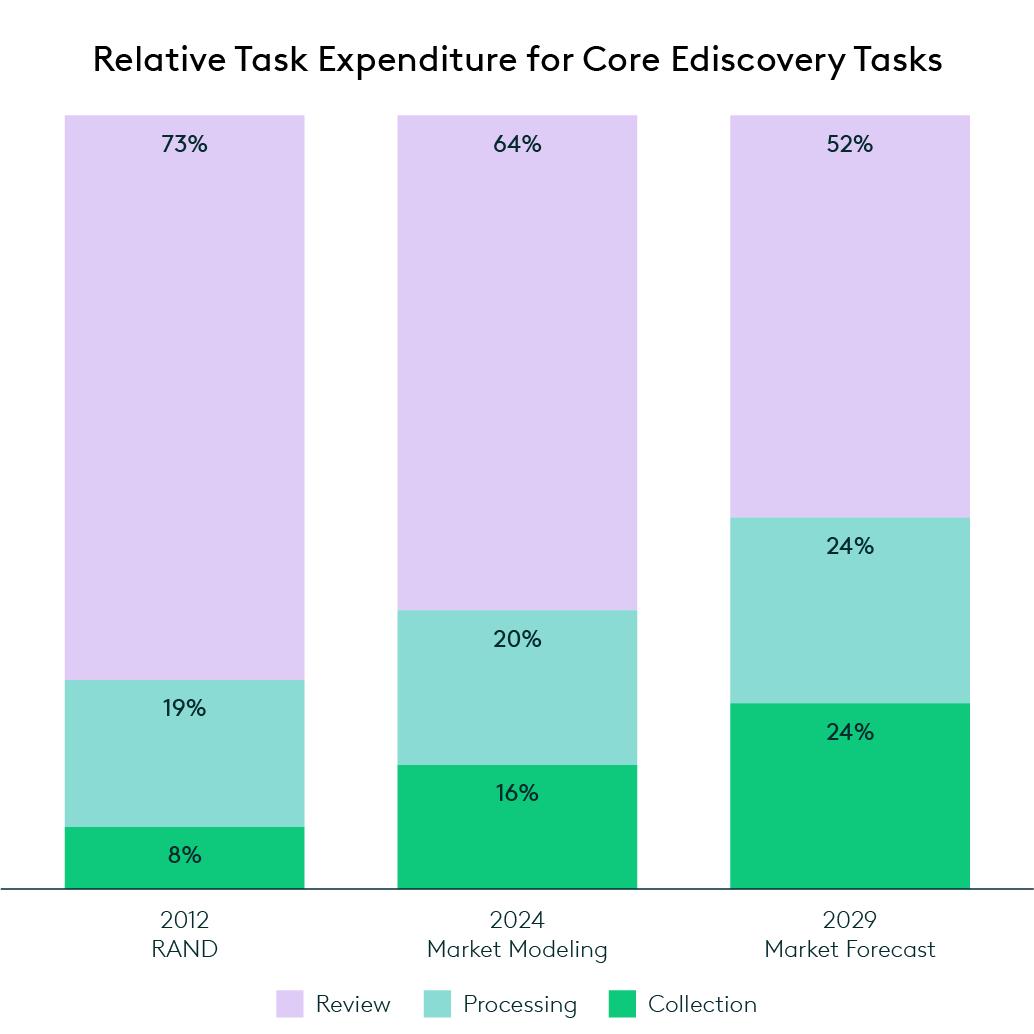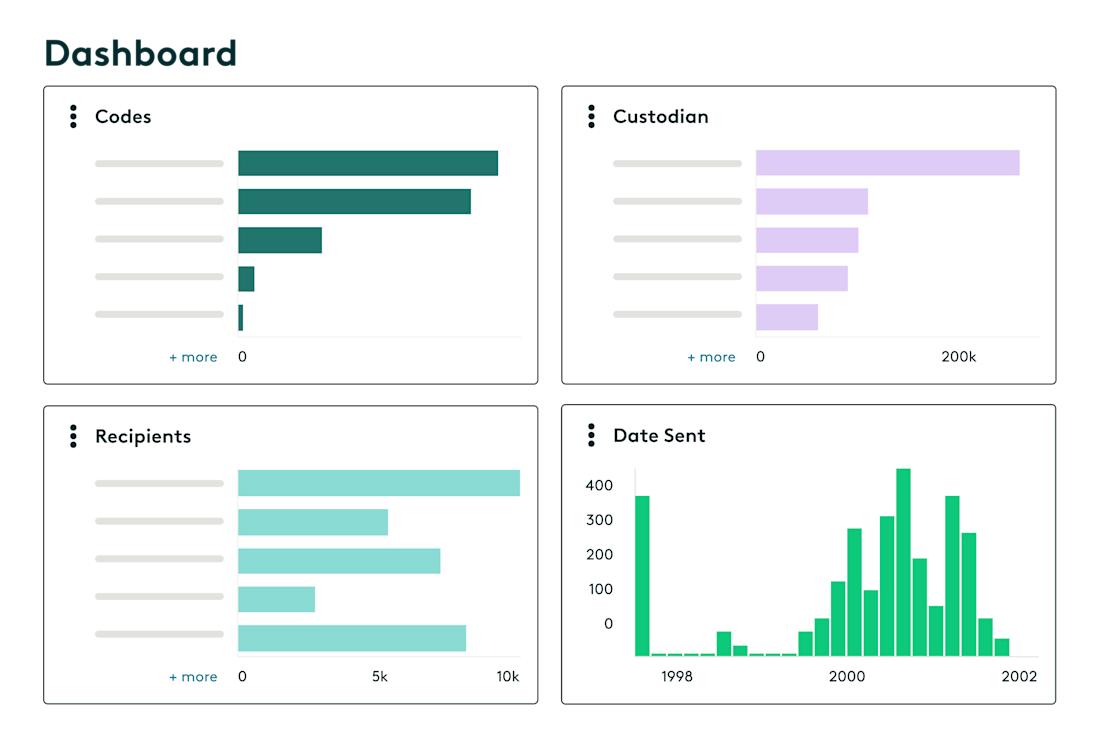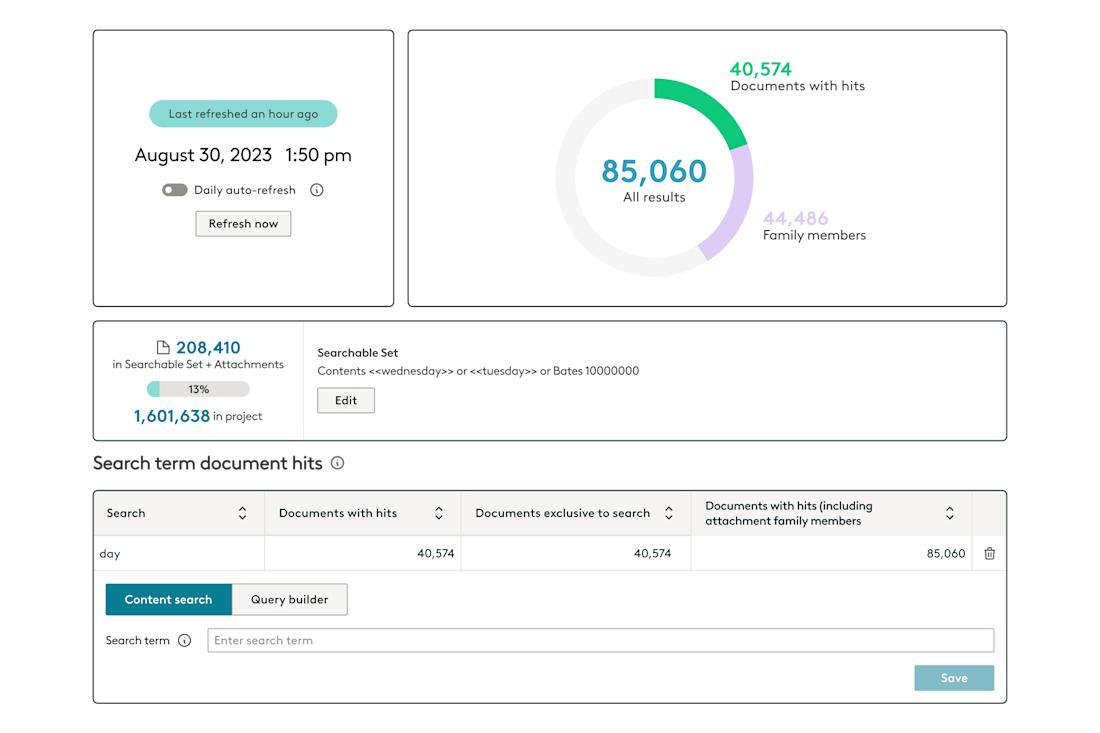Early Case Assessment
Data in the world has risen from 2 zettabytes in 2010 to 149 zettabytes last year – which is 149 trillion gigabytes! And it's expected to grow to more than 394 zettabytes by 2028 – which is nearly 200 times as much data in only 18 years. The meteoric rise in data volumes has carried over to ediscovery, where we are managing much higher data volumes than ever before.
Historically, review costs have constituted anywhere from 65 to 75 percent of the total cost of an ediscovery project. So, the dramatic rise in data volumes have led to corresponding increases in review costs, forcing legal teams to identify ways to reduce the number of documents subject to review to keep ediscovery costs manageable. According to ComplexDiscovery, the review phase in ediscovery was as high as 73% of total ediscovery costs in 2012 but dropped to 64% as of 2024 and is expected to drop to 52% by 2029. Transformative approaches to ediscovery review are part of the reason why the percentage of review costs has dropped over the years.

Another reason is the emergence of early case assessment (ECA) as a best practice. ECA has emerged as a process to quickly evaluate the facts, risks, and costs associated with a legal matter at the outset of a case to make important decisions about the case itself, as well as to develop an understanding of your data much more quickly to reduce the volume of data that needs to be reviewed. For example, law firms have leveraged ECA on Everlaw to reduce data volumes to be reviewed by over 70%.
What Is ECA?
So, what is ECA? Depending on whom you ask, the answer to this question may vary. Not only that, the term(s) related to ECA may also vary, as there are different schools of thought as to what can be considered ECA.
A Straightforward Definition of ECA
ECA is a strategic process used to rapidly investigate and analyze ESI, paper documents, and other evidence at the outset of a potential legal matter. By collecting and assessing this data early, legal teams can evaluate risks, identify key issues, and develop an informed case strategy. This proactive approach enables organizations to determine the most cost-effective and defensible path forward, whether that involves pursuing an early settlement, proceeding to trial, or refining the scope of ediscovery to minimize costs and reduce the burden on all parties involved.
ECA helps legal professionals answer critical questions like:
What are the estimated ediscovery costs?
What is the legal liability?
How much data is there? How much data can defensibly be culled?
How much data requires actual human review?
Who are the significant custodians?
Where does the data reside?
What file types does the data include?
ECA goes beyond simply reviewing potentially relevant evidence; it is a holistic evaluation of legal liability, potential costs, and overall case strategy from the outset. By conducting this thorough analysis early, organizations gain a clearer understanding of the risks and implications, allowing them to make more informed and strategic decisions. This proactive approach provides greater confidence in determining the best course of action for the case.
Early Case Assessment vs. Early Data Assessment
However, not everyone defines ECA the same way. Some ediscovery professionals use a separate term – early data assessment – to relate to the process of reducing the volume of data for downstream tasks like review.
The Sedona Conference Glossary, eDiscovery & Digital Information Management, Fifth Edition provides a definition for both ECA and EDA. It defines early case assessment as “The process of assessing the merits of a case early in the litigation lifecycle to determine its viability. The process may or may not include the collection, analysis, and review of data.”
Whereas early data assessment is defined as “The process of separating possibly relevant electronically stored information from nonrelevant electronically stored information using both computer techniques, such as date filtering or advanced analytics, and human-assisted logical determinations at the beginning of a case. This process may be used to reduce the volume of data collected for processing and review.”
While some ediscovery professionals separate ECA from EDA, many in the industry don’t. In today’s data-centric world, it’s difficult to imagine conducting ECA without involving data. Likewise, the extent to which you can reduce the volume of data for processing and review is key to the decisions you make regarding the merits of the case and determining its viability.
Benefits of ECA
Conducting ECA at the outset of a case provides several benefits in managing discovery and to the litigation overall.
Cost Reduction and Efficiency
The ability to reduce costs and improve efficiency in ediscovery is one of the most significant benefits of ECA. By analyzing data at the outset, legal teams can quickly identify key custodians, relevant data sources, and unnecessary information, allowing them to limit the scope of discovery. This targeted approach minimizes the volume of ESI that needs to be reviewed, ultimately saving time and reducing the financial burden of litigation. Of course, ECA also helps organizations make early strategic decisions, such as whether to settle or proceed with litigation, avoiding unnecessary legal expenses.
Risk Mitigation and Compliance
ECA also plays an important role in risk management by allowing legal teams to assess potential liabilities and regulatory compliance concerns early in the process. By quickly identifying sensitive or privileged information, organizations can take steps to protect confidentiality and ensure they meet legal and regulatory obligations. This proactive approach also helps prevent inadvertent data spoliation, sanctions, or other discovery-related pitfalls that could negatively impact a case. With data privacy regulations such as the General Data Protection Regulation (GDPR) imposing strict requirements on data handling, ECA enables companies to maintain compliance while effectively managing legal risks.
Strategic Case Planning
A well-executed ECA process provides valuable insights that guide case strategy and decision-making. By evaluating the strength of the evidence early, legal teams can determine whether to negotiate a settlement, file a motion to dismiss, or prepare for trial. ECA also allows organizations to identify potential weaknesses in their position, giving them the opportunity to refine their legal arguments or gather additional evidence before moving forward. This level of strategic planning helps ensure that resources are allocated efficiently, and that the organization is well-prepared for the next steps in litigation.
Improved Negotiation and Settlement Decisions
Understanding the merits of a case early in the process for strategic planning purposes also helps define an organization’s position in settlement negotiations. With ECA, legal teams can assess the strengths and weaknesses of both their own case and the opposing party’s case, allowing them to enter negotiations with a well-informed strategy.
If the data suggests a high likelihood of success in court, organizations may choose to proceed with litigation; conversely, if risks outweigh potential rewards, an early settlement may be the best course of action. This informed approach helps avoid protracted and costly legal battles while ensuring favorable outcomes.
Better Collaboration Between Legal and IT Teams
ECA fosters stronger collaboration between legal, IT, and compliance teams by expediting the identification and collection of relevant data. Given the increasing complexity of data storage across multiple platforms – including collaborative and other cloud-based systems, mobile devices, and social media – effective communication between these teams is essential.
Legal professionals benefit from IT expertise in locating and preserving relevant ESI, while IT teams gain a clearer understanding of legal priorities and requirements. This alignment leads to a more efficient ediscovery process, reducing delays and minimizing the risk of overlooked or mishandled data.
Increased Predictability and Defensibility
By leveraging ECA, organizations can improve the predictability of litigation outcomes and enhance the defensibility of their discovery process. Courts increasingly expect parties to take a reasonable and proportional approach to ediscovery, and a well-documented ECA process demonstrates diligence and good faith efforts to comply with legal obligations. This proactive stance helps organizations defend their discovery decisions if challenged and reduces the risk of sanctions for over-preservation or failure to produce relevant evidence.
Additionally, leveraging AI and analytics in ECA allows for data-driven insights, further strengthening an organization’s ability to anticipate and manage legal challenges effectively. In short, the more you know and the earlier you know it, the better prepared you will be to determine how to proceed with the case, and how to do so as efficiently and effectively as possible.
ECA Best Practices
Like any discipline, the effectiveness of an ECA process depends on defining the right goals and ensuring the process is structured to meet those goals. As part of keeping your ECA policy evergreen, your organization should regularly revisit case strategies, reassess risk factors, and adjust data collection efforts as needed. Incorporating feedback from past cases and leveraging lessons learned can help organizations continuously improve their ECA methodologies.
By staying adaptable and proactive with an evergreen ECA policy, legal teams can ensure that their ECA approach remains effective in an evolving legal and technological landscape.
Establish Clear Objectives and Case Priorities
As with any project, success depends on understanding what “done” looks like. A successful ECA process begins with gathering context about the case so that you can define clear objectives and priorities for the case. Examples of things to consider include:
The timeline of events.
The issues at hand.
The number of parties involved.
Where to find the evidence.
Arguments or evidence that can hurt the case.
Legal teams should work closely with internal stakeholders to determine key questions, potential risks, and desired outcomes. Establishing these priorities upfront helps ensure that data collection and analysis efforts are focused on the most relevant information. By aligning the ECA process with overall case strategy, organizations can avoid unnecessary data review and make informed decisions about settlement, litigation, or alternative dispute resolution.
Involve Key Stakeholders Early
Just as information governance requires stakeholder collaboration within an organization, effective ECA requires collaboration between legal, IT, compliance, and business teams. Involving key stakeholders early in the process ensures that important data sources are identified, preservation requirements are met, and potential legal or regulatory risks are addressed.
IT teams play a crucial role in locating and extracting data from various systems, while compliance officers help ensure adherence to privacy and security regulations. By fostering early communication and cross-functional coordination, organizations can reduce the risk of missing important information, yet streamline ediscovery workflows for more efficient discovery.
Implement a Defensible Data Preservation Strategy
One of the primary goals of ECA is to not only understand what potentially relevant data you have, but also to ensure that data is preserved in a defensible manner. Organizations should establish clear procedures for legal holds and communicate them to relevant custodians to prevent data spoliation. Implementing automated legal hold solutions can help track compliance and reduce the risk of inadvertent data loss. Additionally, maintaining detailed documentation of preservation efforts ensures transparency and defensibility in court, should the organization’s discovery process be challenged.
Focus on Proportionality and Cost Control
A well-executed ECA strategy emphasizes proportionality, ensuring that discovery efforts remain reasonable and cost-effective. Legal teams should assess the scope of discovery based on factors such as the relevance of data, potential legal exposure, and litigation costs, so that they can be in the best possible position to negotiate scope with opposing counsel.
Additionally, by identifying and eliminating redundant or non-relevant data early, organizations can significantly reduce processing, review, and storage costs. Leveraging targeted search techniques, such as keyword search and concept clustering, further enhances efficiency while maintaining compliance with discovery obligations.
Document the ECA Process for Defensibility
Maintaining a well-documented record of ECA activities is essential for demonstrating good-faith efforts in discovery. Organizations should track key decisions, data sources analyzed, search methodologies used, and any scope adjustments made throughout the process.
This documentation can be key to supporting your position in discovery disputes, particularly if opposing parties challenge the scope or approach of ediscovery. A clear and defensible ECA process not only helps mitigate risks but also enhances credibility in legal proceedings. Despite your best efforts, mistakes sometimes happen. Courts are much more likely to be lenient when you’ve documented your best efforts to comply with your discovery obligations.
Leverage Advanced Analytics and AI
Modern ECA relies heavily on technology to quickly analyze large volumes of ESI. Leveraging advanced analytics such as data visualization, clustering, search term reports, predictive coding, and AI tools allows legal teams to identify relevant documents, detect patterns, and assess potential case risks more efficiently. AI-powered solutions can categorize documents, flag privileged or sensitive information, and surface key facts early in the process. By integrating these technologies, organizations can reduce the manual burden of document review and accelerate the decision-making process.
Develop an ECA Policy to Formalize Best Practices
ECA is not a “one and done” type of event. It’s an iterative process that should be refined as new information emerges. An ECA policy is a structured framework that formalizes the ECA process, defining the processes, roles, and technologies used to assess case risk, costs, and strategy before full-scale ediscovery begins.
A well-drafted ECA policy establishes clear guidelines for identifying, collecting, analyzing, and preserving relevant ESI while ensuring compliance with legal, regulatory, and internal governance requirements. It also integrates workflows for cross-functional collaboration between legal, IT, compliance, and business teams, ensuring that ECA efforts are both consistent and defensible.
ECA Tools for Prioritizing Review
Developing a comprehensive understanding of your data as quickly as possible is essential to an effective ECA process. Given today’s huge data volumes, effectively leveraging technology is vital to develop that understanding. While technology capabilities are rapidly evolving, there are several proven approaches and tools that can help streamline the ECA process.
Data Visualization
Data visualization helps legal teams transform large volumes of complex electronic data into easily digestible visual insights. Through interactive dashboards, timelines, and other analytics, teams can quickly identify key trends, patterns, and relationships within the data, allowing for a more efficient and targeted approach to ediscovery. Leveraging these visual tools also helps organizations rapidly assess potential risks, uncover vital evidence, and make informed decisions about case strategy, ultimately reducing costs and improving the efficiency of the discovery process.

Concept Clustering
Concept clustering enhances ECA by automatically grouping related documents based on themes, topics, or patterns rather than relying solely on keyword searches. This AI-driven approach enables legal teams to quickly identify groups of potentially relevant documents, and (just as importantly) groups of documents that are clearly not relevant. It also helps uncover hidden connections within large data sets, even when key terms are unknown or inconsistently used.
By visualizing clusters of similar documents, teams can more efficiently prioritize review, spot trends and anomalies, and eliminate irrelevant data early in the process. Concept clustering also helps identify privileged, sensitive, or high-risk content faster, supporting streamlined decision making.

Search Term Reports
Search term reports are another key tool to facilitate ECA by providing legal teams with a quantifiable overview of keyword effectiveness within large datasets, helping refine discovery scope early in the process. These reports analyze how frequently specific terms appear in collected data – including how many documents are unique to a specific search term within a group of search terms – highlighting potentially relevant documents, key custodians, and emerging case themes.
By reviewing hit counts, identifying false positives, and exploring search term variations, legal teams can fine-tune search strategies to improve precision and reduce the volume of non-relevant documents requiring review. This targeted approach not only saves time and costs but also enhances defensibility by documenting a transparent and data-driven methodology for narrowing discovery.

Predictive Coding
While many legal professionals think of predictive coding as a tool to be used in responsiveness review, it’s also an excellent ECA tool to facilitate developing an understanding of your data more quickly. Just as with responsiveness review, predictive coding can train the system on a small subset of reviewed documents to identify patterns and apply learned relevance criteria to the entire dataset, helping to identify the most important documents early in the process. This allows legal teams to quickly assess case merits, spot important evidence, and make informed decisions about settlement or litigation strategy.


